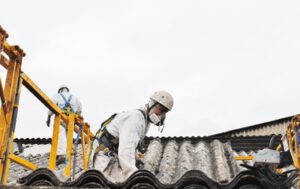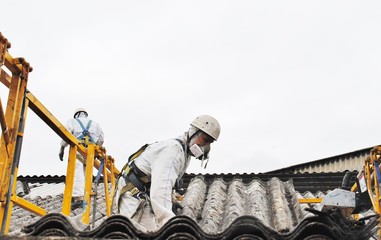Professionals remove asbestos by wetting the materials, which prevents fibers from becoming airborne. They double-bag the material and seal it in a sturdy, leak-proof container.
Then, they transport it to a site vetted for safe handling and disposal. The waste is then put through a high-temperature process that converts it to glass or glass ceramic and renders it nonhazardous. Click https://www.perthasbestosremovalwa.com.au/ to learn more.

Several methods can be used to handle and dispose of asbestos. These include encapsulation, dry removal, wet removal, and disposal in designated landfills. It is important to follow all applicable rules and regulations when disposing of asbestos. Failure to do so can result in fines, incarceration, and/or imprisonment.
The two primary agencies responsible for setting regulations regarding asbestos are the Environmental Protection Agency and the Occupational Safety and Health Administration. Both have resources available online that can be accessed by homeowners and business owners. It is also important to check with your county and state departments of environmental quality for any additional information that may be pertinent to your location.
If you are removing asbestos, it is important to prepare the work area before beginning the project. This includes covering surfaces that don’t need abating, using negative air pressure units, and posting warning signs to inform others that asbestos work is taking place. Workers should wear a respirator and protective clothing during the entire process.
All waste containing asbestos must be wetted before it can be double bagged and sealed in plastic containers with lids for disposal. Any materials that cannot be wetted should be wrapped in a layer of plastic or heavy-duty paper and then placed in a leak-proof container. The container must be labeled as asbestos waste and disposed of in a special landfill.
Even slightly damaged asbestos material can pose a danger if the fibers are released into the air and inhaled. It is best to leave asbestos material alone if it is in good condition and to seek professional help if it is damaged.
Homeowners and businesses can safely remove or replace slightly damaged asbestos insulation, drywall, or sheet flooring by contacting professionals who are trained in handling asbestos. However, it is best to contact a professional before doing any home remodeling, as asbestos materials that are disturbed are more likely to release dangerous fibers. This is particularly true if the material has become brittle or water-damaged. It is also important to avoid sanding, drilling, sawing, or scraping asbestos-containing materials.
Asbestos has been used in many construction and insulation materials in the past, but today it’s known to be a dangerous and deadly substance. That’s why the federal government regulates its use and requires asbestos abatement professionals to take special care when removing it from buildings. Asbestos recycling could help bring us closer to an asbestos-free world, but only if it is done correctly.
The process of recycling asbestos isn’t as simple as putting a can in the recycle bin. It’s much more complicated because the material must be separated out from other materials and then turned into something completely different. The goal is not to reuse the asbestos as it is, but to turn it into ceramics or glass. This is a very expensive process that is not currently available to the general public.
Until it becomes more affordable, the best option for anyone wanting to get rid of asbestos is to have it properly disposed of by an experienced professional. That’s because it is not safe to try on your own, even when the material has been pulverized or reduced to powder. This can release the fibers into the air, which is why only professionals should ever do it.
When the material is ready to be disposed of, it needs to be placed in leak-proof and non-returnable containers such as plastic bags that are at least six mils thick, drums, boxes or cartons. It also has to be wetted down to prevent the fibers from escaping if the container is damaged. It then needs to be sealed, labeled and transported to a designated landfill for disposal. All of this takes a lot of time and resources, but it’s the only way to ensure that the dangerous fibers won’t be released into the environment.
Researchers are working to find a better way to recycle asbestos, and one possible method involves changing the structure of the fibers. This would render them less dangerous, but it is a long-term solution that will have to be perfected before it can become widespread.
Asbestos is dangerous and can’t be simply thrown away like garbage. Instead, asbestos must be transported to a landfill specifically designated for hazardous waste. It’s important that asbestos be kept out of landfills because it is extremely difficult to recycle and it can cause a variety of health concerns, including mesothelioma.
When asbestos is disposed of in a landfill, it goes in a sealed and labeled container that has to be specially designed for safe disposal. It must also be wetted to prevent fibers from becoming airborne. The landfill will then bury the waste to minimize risk of leaks and emissions.
Before attempting to remove or work with asbestos, homeowners should contact their local waste management agency for guidelines. They may also need to contact a state or city environmental quality control agency for specific handling requirements. Additionally, they should check with their local clean air agencies to learn about licensing and working standards for asbestos abatement professionals.
The two primary government agencies responsible for setting regulations on how to handle and dispose of asbestos are the Environmental Protection Agency and the Occupational Safety and Health Administration. Additionally, it’s a good idea to read guides that universities and other institutions publish on the topic of working with asbestos.
During asbestos removal projects, contractors will wet the materials before using various tools to cut and remove it from buildings. This helps prevent the harmful particles from becoming airborne and causing additional damage. After removal, all of the materials will be double-bagged and placed in a container that can only be transported to landfills approved for handling hazardous waste.
While it isn’t possible to recycle all forms of asbestos, scientists are looking into ways to transform some forms of asbestos into safer materials such as ceramics and glass. Unfortunately, this isn’t available for homeowners because many of the materials in older homes are intertwined with asbestos and can’t be separated without exposing people to harmful particles.
In order to protect residents, it’s essential that the EPA improves its methods of dealing with asbestos. In the meantime, individuals who are concerned about living near an asbestos disposal site can look up Superfund sites on the EPA’s website to see how close they live to such facilities.
Asbestos is a dangerous toxin that poses a health risk when the fibers are inhaled. It was widely used in construction before it was banned in the 1970s, and it can still be found in older homes and buildings. If a homeowner finds material that could contain asbestos, they should contact a licensed asbestos inspector to conduct an inspection and testing. If asbestos is present, the fibers must be sealed off or removed by a professional. Then, the material should be taken to a certified landfill for disposal.
During removal, professionals wet the materials to keep them from becoming airborne. They also wear masks and protective suits during the process. The asbestos is then bundled into tightly packed bags or boxes and placed in leak-proof containers for transport. The waste management company will then bury the containers at a landfill that is licensed to handle asbestos.
Wet asbestos can be more stable than dry, so it requires less packing and fewer leaks. This lowers the risks of storing the material in a landfill and reduces the likelihood that the asbestos will be compacted, which can release deadly dust into the environment.
While most asbestos is buried in landfills, some is recycled. However, this is not an easy task. The contaminated material must first be wet to prevent the fibers from becoming airborne, and it can only be recycled in facilities with the proper licensing and training.
In the United States, asbestos recycling is regulated by several state and federal statutes. For example, the EPA limits effluent discharges of asbestos-containing materials into water under the Resource Conservation and Recovery Act. It also regulates the handling of asbestos in Superfund sites under the Comprehensive Environmental Response, Compensation and Liability Act.
In addition, the EPA’s National Emission Standards for Hazardous Air Pollutants (NESHAP) regulates certain demolition and renovation work involving asbestos. The NESHAP regulations specify that asbestos-containing materials must be wetted before demolition or renovation and that workers must use particular work practices and clean-up procedures. The NESHAP regulations also limit the amount of airborne asbestos released during these projects.
